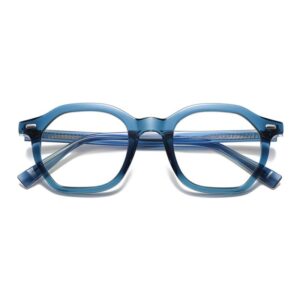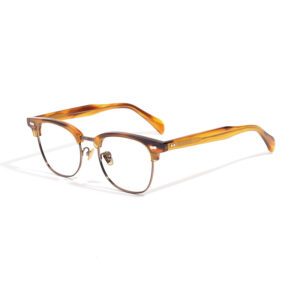I. Introduction
Plastic eyewear frames have become a staple in the modern eyewear industry, renowned for their lightweight construction, versatility, and the vast array of designs available. These frames cater to a wide range of consumer needs, from high fashion to everyday practicality. However, behind every stylish plastic frame is a critical tool: the injection mold. Without injection molds, the mass production of plastic eyewear frames would be impossible, and the precision, consistency, and design complexity we see today would be unachievable. This blog explores the vital role injection molds play in the production of plastic eyewear frames, focusing on their impact on efficiency, quality, and the future of the eyewear industry.

II. The Basics of Injection Molds
To fully appreciate the importance of injection molds, it’s crucial to understand what they are and how they function. Essentially, an injection mold is a specialized tool used to shape plastic materials into specific forms—like eyewear frames. The mold consists of several key components:
| Component | Function |
| Mold Base | Provides the structure and support for the mold components. |
| Cavities | The exact shape of the eyewear frame is formed within these cavities. |
| Gating System | Directs the molten plastic into the cavities. |
| Cooling System | Cools the plastic to solidify the frame shape quickly and evenly. |
The basic process involves heating plastic until it melts, injecting it into the mold, cooling it to solidify the shape, and then ejecting the finished frame. While this process sounds straightforward, every detail of the mold’s design and operation significantly affects the final product’s quality.

Case Example:
Consider a popular eyewear brand that needs to produce thousands of identical frames for a new collection. By using a well-designed injection mold, the company can achieve high efficiency in production, ensuring that every frame meets the precise specifications required for comfort and durability. The consistency achieved through this process allows the brand to maintain its reputation for quality, even as it scales production to meet global demand.
III. Key Roles of Injection Molds in Plastic Eyewear Frame Production

Efficient Production:
Injection molds are the backbone of efficient mass production. Once a mold is created, it can produce thousands or even millions of identical frames with minimal variations. This capability is essential for eyewear brands that need to meet high consumer demand without compromising quality. A well-designed mold can significantly reduce production cycle times by optimizing plastic flow and cooling processes, enhancing overall efficiency.
Precision and Consistency:
The precision and consistency provided by injection molds are unmatched. In eyewear production, even small deviations in size or shape can affect how frames fit and look. Injection molds are designed to maintain extremely tight tolerances, often within micrometers, ensuring that every frame produced meets exact specifications. This precision is crucial for maintaining high-quality standards, particularly for premium brands.
Enabling Diverse Designs:
Injection molds also enable a wide variety of frame designs, from simple shapes to intricate patterns. The flexibility in mold design allows designers to realize complex ideas without significant limitations. This flexibility is critical for eyewear brands that need to continually innovate and offer a range of styles to meet diverse market demands. A well-structured mold can adapt to these varying designs while consistently producing high-quality frames.
-

Bulk Wholesale TR90 Optical Frames – 2095
$50.00 Select options This product has multiple variants. The options may be chosen on the product page -

Bulk Wholesale TR90 Optical Frames Supplier – KY58092
$50.00 Select options This product has multiple variants. The options may be chosen on the product page -

Buy Fashion TR90 Eyewear in Bulk – 8600
$50.00 Select options This product has multiple variants. The options may be chosen on the product page -

Wholesale TR90 Optical Frames – JCF8348
$50.00 Select options This product has multiple variants. The options may be chosen on the product page
Case Example:
A luxury eyewear brand sought to create a limited-edition collection featuring frames with intricate geometric patterns. The brand used a custom-designed injection mold with detailed cavities and precise flow channels to bring these complex designs to life. The mold’s flexibility allowed the brand to maintain the high quality and consistency its customers expect while offering a unique product that stood out in the market.
Cost Control in Production:
Although the initial cost of creating an injection mold can be high, this investment pays off over time. Once in use, a mold can produce many frames at a low cost per unit. The mold’s durability and efficiency spread the initial cost over many products, reducing the overall production cost. A durable mold that requires minimal repairs or replacements further enhances cost-effectiveness, allowing brands to maintain profitability while delivering quality products.
IV. How Mold Design Affects Eyewear Frame Quality
Material Selection for Molds:
The choice of material for the mold impacts both its longevity and the quality of the frames produced. High-quality mold materials, such as S136 steel, offer excellent polishability and corrosion resistance, essential for creating smooth, defect-free frames. These materials must endure repeated production cycles without degrading, ensuring consistent mold performance.
Impact of Mold Design on Frame Quality
| Design Element | Impact on Frame Quality |
| Flow Channel Design | Ensures even plastic distribution, preventing surface defects like blemishes or weak points. |
| Cooling System | A well-designed cooling system reduces warping and ensures uniform solidification, enhancing overall frame quality. |
| Venting System | Proper venting prevents air bubbles and imperfections, resulting in smoother, higher-quality frames. |
These design elements work together to ensure that the frames produced are strong, aesthetically pleasing, and free from defects.

Case Example:
An eyewear manufacturer experienced issues with bubbles and imperfections in their frames. After analyzing the problem, they discovered that the venting system in their mold was insufficient, trapping air during the injection process. By redesigning the mold with improved venting, they eliminated the defects, resulting in higher-quality frames and reduced waste.
V. Maintenance and Management of Injection Molds

Regular Maintenance:
Injection molds are a significant investment, and regular maintenance is key to keeping them performing at their best. Routine maintenance helps prevent common issues like wear, cooling system blockages, and residue buildup in the flow channels. Addressing these issues early on prevents costly production delays and ensures that the mold continues to produce high-quality frames.
Care and Repair:
Even with regular maintenance, molds will eventually wear out. Regular care, such as repolishing the mold to maintain a smooth surface, is crucial for extending its lifespan and ensuring consistent product quality. Prompt repairs, such as fixing cracks or replacing worn parts, are essential to prevent further damage and maintain the mold’s integrity.
Mold Management Systems:
Many companies use mold management systems to monitor each mold’s usage, maintenance history, and performance. These systems help optimize the use of each mold, reducing downtime and improving efficiency. By tracking detailed records and using data to predict when maintenance or repairs are needed, these systems ensure molds remain in top condition, supporting consistent, high-quality production.
Case Example:
A manufacturer implemented a mold management system that tracked each mold’s performance, including production cycles and maintenance needs. By analyzing this data, they could schedule maintenance during low-demand periods, minimizing production disruptions and extending the life of their molds. This proactive approach also helped them identify and address potential issues before they impacted production, ensuring consistent quality.
VI. The Environmental and Sustainability Benefits of Injection Molds

Reducing Material Waste:
Sustainability is increasingly important in manufacturing, and injection molds contribute by reducing waste. Optimizing mold design can minimize the amount of plastic left in the gating system after each cycle, reducing material waste. This efficiency cuts costs and lessens the environmental impact of production.
Improving Energy Efficiency:
Efficient cooling systems in injection molds can also lower energy consumption. By shortening the cooling time, these systems reduce the overall production cycle, allowing more frames to be produced with less energy. This efficiency benefits the bottom line and helps reduce the carbon footprint of the manufacturing process.
Extending Mold Life and Environmental Impact:
Long-lasting molds are better for the environment because they reduce the need for new molds, saving resources and minimizing waste. By properly maintaining and extending the life of a mold, manufacturers can decrease their environmental impact while saving money. Durable molds mean fewer replacements and less waste, aligning with sustainable manufacturing goals.
Case Example:
A company specializing in eco-friendly eyewear focused on extending the lifespan of its molds as part of its sustainability strategy. By investing in high-quality materials and regular maintenance, they were able to reduce the frequency of mold replacements, which in turn lowered their carbon footprint and production costs. This approach not only supported their environmental goals but also enhanced their brand image as a leader in sustainable fashion.
VII. Future Trends in Injection Mold Technology

Smart Manufacturing and Mold Automation:
As technology advances, injection mold manufacturing is becoming more intelligent and automated. Smart sensors and automated systems monitor mold conditions in real-time, making adjustments to maintain optimal performance. This automation improves efficiency and enhances product quality by reducing the likelihood of defects.
Advanced Materials:
New materials in mold manufacturing, such as advanced alloys and coatings, are improving mold durability and reducing maintenance needs. These materials allow for more complex designs and higher precision, pushing the boundaries of what’s possible in eyewear frame production.
Digital Design and Simulation:
Digital tools in mold design, like CAD software and simulation tools, allow designers to test and refine mold designs before production. These simulations save time and money by reducing the need for prototypes and ensuring that the final mold design is efficient and effective. This trend toward digitalization is expected to continue, making mold design faster, more accurate, and more cost-effective.
Case Example:
An eyewear company adopted digital design and simulation tools to develop a new line of frames. By simulating the injection molding process, they identified potential issues with material flow and cooling before the mold was built. This proactive approach allowed them to refine the design, resulting in a mold that produced high-quality frames with fewer defects and faster cycle times.
VIII. Conclusion
Injection molds are crucial in producing plastic eyewear frames, enabling efficient mass production, ensuring precision and consistency, and allowing for diverse and innovative designs. They also play a significant role in controlling production costs and contributing to sustainable manufacturing practices. As technology advances, the importance of injection molds will only grow, driving the eyewear industry toward greater efficiency, intelligence, and environmental responsibility. Staying current with the latest developments in mold technology is essential for manufacturers and designers to remain competitive and meet the market’s evolving demands.
Frequently Asked Questions (FAQ)
1. What is an injection mold, and why is it important in eyewear production?
An injection mold is a tool used in manufacturing to shape plastic into specific forms, like eyewear frames. It’s essential because it allows for the mass production of high-quality, consistent frames. Without injection molds, producing large quantities of identical eyewear frames with precise dimensions and designs would be challenging and inefficient.
2. How does the design of an injection mold affect the quality of eyewear frames?
The mold’s design directly impacts the quality of the frames. Key design elements like flow channels, cooling systems, and venting systems ensure that the plastic is evenly distributed, cooled uniformly, and free from defects such as bubbles or warping. A well-designed mold produces frames that are strong, smooth, and consistent in quality.
3. What materials are used to make injection molds, and how do they impact the production process?
Injection molds are typically made from high-quality steel, such as S136, which is known for its durability, polishability, and resistance to corrosion. The choice of material affects the mold’s lifespan and the quality of the frames produced. High-quality materials ensure the mold can withstand repeated use without degrading, maintaining consistent production quality.
4. Why is regular maintenance of injection molds necessary?
Regular maintenance is crucial to keep molds in optimal condition, preventing issues like wear and tear, cooling system blockages, and residue buildup. Maintenance helps extend the mold’s lifespan, reduce downtime, and ensure consistent production quality. Without regular maintenance, molds could degrade, leading to production delays and lower-quality frames.
5. How do injection molds contribute to sustainability in eyewear production?
Injection molds contribute to sustainability by reducing material waste and improving energy efficiency. Optimized mold designs minimize plastic waste during production, and efficient cooling systems lower energy consumption by shortening production cycles. Additionally, extending the lifespan of a mold reduces the need for replacements, which conserves resources and lowers the environmental impact.
6. What are the future trends in injection mold technology?
Future trends in injection mold technology include smart manufacturing with automated systems that monitor and adjust mold conditions in real-time. There is also a move towards using advanced materials that increase mold durability and allow for more complex designs. Additionally, digital design and simulation tools are becoming more prevalent, allowing for more precise and efficient mold designs.
7. How does mold design support the production of complex eyewear frame designs?
Mold design is highly flexible, allowing for the creation of diverse and intricate eyewear frame designs. Designers can incorporate complex shapes, patterns, and textures into the mold cavities, enabling the production of unique frames that meet market demands for variety and innovation. This flexibility in design helps brands stay competitive by continually offering new styles.
8. What are the common issues that can arise with injection molds, and how are they resolved?
Common issues include air bubbles, surface defects, and wear on the mold. These problems can often be resolved by improving the venting system, adjusting the flow channel design, or repolishing the mold surface. Regular maintenance and timely repairs are crucial to addressing these issues before they affect the production quality.
9. Can a single injection mold be used to produce different eyewear frame designs?
Typically, a single injection mold is designed to produce a specific frame design. While some mold components might be reusable or adaptable, creating a different frame design usually requires a new or modified mold. This ensures that each design is produced with the precision and quality that meets the brand’s standards.
10. What role does digital design play in modern injection mold manufacturing?
Digital design tools, such as CAD software, allow designers to create detailed mold designs and simulate the injection process before the mold is built. This technology helps identify potential issues early, reduces the need for physical prototypes, and ensures that the final mold is efficient and effective. Digital design is a growing trend that is making mold manufacturing faster, more accurate, and more cost-effective.
Receive Custom Guidance
Looking for the perfect custom eyewear to represent your brand?
Reach out to Eyewearbeyond for expert guidance on choosing the best materials, styles, and customizations for your eyewear collection!
























